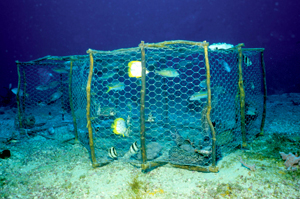Other Integrated Approaches
Management efforts have conventionally focused on either productivity (resource management) or conservation (biodiversity protection). However, the current situation — called a crisis by some experts ref — is demanding a more holistic and integrative approach to coral reef management that also includes stakeholders in the decision-making processes.
The following sections introduce several other integrated approaches to management in addition to RBM that can help managers deal with the complex interdependencies in coral reef systems and balance the short-term needs of society with the longer-term mandate for sustainability.

The reef ecosystem extends beyond its physical boundary to include the neighboring habitats with which it interacts, especially seagrass beds, back-reef lagoons, and mangroves which provide important fish nurseries. All these linked habitats must be considered and managed as parts of a single functional unit. Photos © Stephanie Wear/TNC
Ecosystem-based management (EBM) is an integrated management approach that considers the entire ecosystem, including humans. EBM considers the cumulative impacts and interactions of human activities on the whole ecosystem. While there are many definitions of EBM, its goal can be simply stated: to maintain an ecosystem in a healthy, productive, and resilient condition so that it can provide the services humans want and need. EBM is characterized by an emphasis on the protection of ecosystem structure, functioning and key processes, rather than just a few key species or indicators of system state. It is also place-based as it focuses on a specific ecosystem and the range of activities affecting it. EBM explicitly accounts for the interconnectedness among systems, such as between air, land and sea, and it aims to integrate ecological, social, economic and institutional perspectives, recognizing their strong interdependencies. Ecosystem-based management is built around eight core elements: ref
- Sustainability — Sustaining ecosystem services through future generations.
- Goals — Measurable goals that specify future processes and outcomes.
- Sound ecological models and understanding — Research at all levels of ecological organization provides the understanding of processes and cross-scale interactions.
- Complexity and connectedness — Biological diversity and structural complexity strengthen ecosystems against disturbance and support adaptation to long-term change.
- Dynamic character of ecosystems — Change and evolution are inherent in ecosystems, and EBM approaches focus on system processes rather than aiming to preserve a particulate system state.
- Context and scale — Ecosystem processes operate over a wide range of spatial and temporal scales, so that system behavior is highly contextual. EBM approaches need to be designed for specific local circumstances.
- Humans as ecosystem components — Ecosystem management recognizes the influence of humans on ecosystems, and vice versa.
- Adaptability and accountability — Understanding of ecosystem function and behavior are evolving, and decisions are often made with incomplete knowledge. Management must be viewed as hypotheses to be tested and improved in a continuous learning approach.

The need for a wider consideration of environmental and ecosystem issues in fisheries has been acknowledged. Photo © Ned Deloach/Marine Photobank
The Ecosystem Approach to Fisheries Management (EAFM) advocates a holistic approach to resource management that recognizes maintenance of ecosystem functions and services as a primary objective for fisheries management. EAFM shares many principles with ecosystem-based management (EBM), but with a particular focus on management of uses of fisheries resources. EAFM explicitly integrates the broader set of fisheries-related benefits derived from the ecosystem into management considerations, including other — often conflicting — uses of marine resources. It also has a strong focus on incorporating uncertainties, variability, and predicted changes into fisheries management. EAFM involves a precautionary approach that encompasses the whole system, rather than being driven by a simple goal of maximizing harvest of a target species. The ecosystem approach greatly increases the alignment in management objectives between fisheries and reef conservation, potentially allowing for a collaborative approach with a shared focus on building reef resilience.

Biodiversity conservation and fisheries productivity objectives can be integrated in a single planning framework. Photo © Chris Seufert
The emergence of EAFM creates many opportunities for coral reef managers to work with fisheries managers in the conservation of reef ecosystems. EAFM is gaining prominence and increasingly being adopted in national fisheries policies. It is the principle approach to fisheries management advocated by the Food and Agriculture Organization (FAO) of the United Nations to comply with the FAO Code of Conduct for Responsible Fisheries. FAO have identified the following principles for EAFM:
- Fisheries should be managed to limit their impact on the ecosystem to the extent possible.
- Ecological relationships between harvested, dependent, and associated species should be maintained.
- Management measures should be compatible across the entire distribution of the resource (across jurisdictions and management plans).
- The precautionary approach should be applied because the knowledge on ecosystems is incomplete.
- Governance should ensure both human and ecosystem wellbeing and equity.
EAFM includes four main planning steps:
- Initiation and scope — This step asks managers: What are you going to manage and what objectives do you want to achieve?
- Identification of assets, issues, and priority — This step requires managers to identify all the relevant issues for the fishery and determine which of them need direct management intervention for the fishery to achieve its objectives.
- Development of the EAFM system — This step works to determine the most appropriate set of management and institutional arrangements needed to achieve the objectives.
- Institutionalization, monitoring, and performance review — This step establishes the new management system and reviews its performance.

Integrating the needs of coastal ecosystems, humans and natural processes can result in a successful MPA Network plan. Photo © Stephanie Wear/TNC
Coral reefs often occur within the complex and highly interconnected coastal zone. Activities within the coastal zone (e.g., urban development, agriculture, and river management) can be major influences on the health of coral reefs.
Coastal zone management (CZM), also termed integrated coastal zone management (ICZM), is a process of governance that can help coral reef managers ensure development and management plans for the coastal zone incorporate environmental and social goals relating to coral reefs. CZM provides a legal and institutional framework that aims to support efforts to maximize the benefits provided by the coastal zone, including coral reefs, while minimizing conflicts and harmful effects of activities upon each other, on resources, and on the environment.ref Key features of CZM processes are that they involve active participation by those affected by coastal zone management and planning decisions, and that they are inter-disciplinary and inter-sectorial.
CZM is often achieved through spatial planning approaches, and in this regard it can have much in common with marine spatial planning (MSP). CZM can also include areas of watersheds (river catchments), and therefore can overlap with watershed or ‘ridge-to-reef’ management. Generally, however, CZM is practically limited to the habitats and landforms readily recognized as ‘the coast’, with spatial definitions often aligning with administrative or jurisdictional boundaries.
Strategies for a CZM approach to protecting coral reefs include:
- Determine whether traditional principles or resource management measures exist and whether their appropriate implementation could enhance coastal resource management.
- Engage local communities to extract anecdotal and traditional knowledge, to involve local stakeholders in policy planning and implementation, and to create local support for coastal management policies.
- Inventory coastal environments, resources, and programs to learn about, improve the health, and better manage the coastal environment.
- Determine short-term and long-term goals that call for coastal development consistent with the preservation of the environment and create a strategy for coastal zone management.
- Create and enforce a strong legal and institutional framework, including economic incentives to reinforce desired behaviors and outcomes.
- Develop a strong coastal management constituency and partnerships at the local, regional and national levels.
- Establish Marine Protected Areas (MPAs), including no-take reserves, to protect, preserve and sustainably manage species and ecosystems of special value (this includes threatened species and habitats).
- Perform Environmental Impact Assessments (EIAs) of all development projects in the terrestrial and aquatic sections of the coastal zone.
- Assess and monitor pollutants in the water column and plan for pollution control.

Scientists, agencies and organizations increasingly are using systematic planning approaches to identify where and how to allocate effort in conservation and management, particularly at regional levels. Photo © Mark Godfrey/TNC
Marine spatial planning (MSP) is a coordinated approach to designating where human activities occur in the ocean to minimize conflicts among stakeholders, maximize the benefits that people receive from the ocean, and help maintain healthy marine habitats. MSP has been defined as the “process of analyzing and allocating parts of the three-dimensional marine spaces to specific uses, to achieve ecological, economic and social objectives that are usually specified through the political process”. The major output from an MSP process ref is usually a comprehensive plan or vision for a marine region, including implementation and management planning. MSP is usually the approach used for achieving the goals of ecosystem-based management (EBM) and coastal zone management (CZM).
Several benefits of using MSP as a tool for achieving EBM and CZM include:
- Addresses social, cultural, economic, and environmental objectives with a holistic approach
- Integrates marine objectives (both between policies and between different planning levels)
- Improves site selection for development or conservation; more strategic and proactive approach that delivers long-term benefits
- Supports coordinated management at the scale of ecosystems as well as political jurisdictions
- Reduces conflicts among uses in the marine area
- Reduces risk of marine activities damaging marine ecosystems including improved consideration of cumulative effects
An MSP process can help resolve some of the biggest challenges associated with the ‘open access’ or ‘common’ nature of marine resource use (and overuse!). However, to be effective, MSP needs to be implemented with a strong commitment to process, engagement, and follow through. MSP should be an ongoing, iterative process that includes stakeholder participation which leads to management outcomes.
Resources
Principles and Practice of Ecosystem-Based Management
EAFnet Ecosystem Approach to Fisheries Toolbox
Coral Reef Alliance Sustainable Coastal Development
European Commission Integrated Coastal Zone Management
NOAA Coastal and Marine Spatial Planning
UNESCO Marine Spatial Planning Programme
OpenChannels: Forum for ocean planning and management
A Step By Step Approach to Ecosystem-based Management
World Bank Oceans, Fisheries and Coastal Economies
Marine Spatial Planning in the Context of the Convention on Biological Diversity
